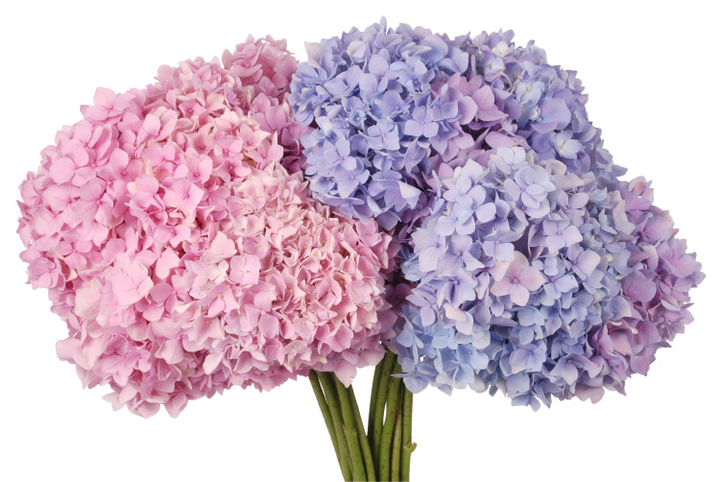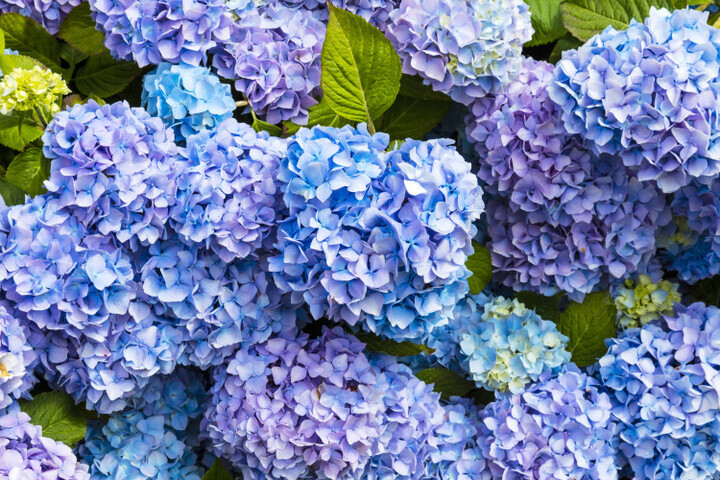
Producing healthy hydrangea plants requires just a few simple growing tips, which we’ve aimed to detail here.
By following these you should be able to enjoy colourful blooms for many years to come, as this specie can help to transform your outdoor space.
Hydrangea – Care Guide

Planting your Hydrangea
For best results, you should plant Hydrangeas in early spring.
When planting, it’s important to remember that both the stems and the blooms require protection from hot afternoon sun and strong winds.
This is why it’s a good idea to choose a sheltered eastern spot (next to a wall is the perfect location), as open areas are generally more susceptible to winds.
Watering your Hydrangea
To avoid root rot, make sure your plant has good drainage. If the soil is too saturated, the plant will die.
Add an all-purpose slow-release fertiliser and a great deal of organic matter to the soil – this will help give your hydrangea a good start.
Basic Hydrangea Care
If planting Hydrangeas in the summer months, it’s a wise idea to give them a great deal more water at the beginning, as this will help to establish the root system.
Provided they are planted in moist, rich soil, the majority of Hydrangeas will thrive in both partial shade and full sunlight. If the weather is extremely hot or dry, just add more water.

Hydrangea fertilisation
When it comes to fertilisation, Hydrangea needs vary greatly.
This all depends on the intended colour of bloom you wish to achieve.
Certain elements of fertilisers can have an effect on the soil’s pH, which can change the colour of the flowers, particularly the pink and blue Hydrangea varieties.
Pruning Hydrangea
Hydrangeas can live for a great deal of time with little maintenance and certain species never need to be pruned. However, if your Hydrangeas are looking a little unruly, it’s wise to trim failing flowers and stems back. This will encourage new growth and generous flowers for the next year.
Different species
Hydrangea macrophylla and H. quercifolia: These species of Hydrangea require little care or pruning. If you do notice dead blooms, remove these immediately post flowering (this is usually around midsummer).
Hydrangea macrophylla (Bigleaf, Mophead, or Lacecap Hydrangeas): These Hydrangeas start flowering early to midsummer, with blooms often outlasting the summer months. This means buds tend to appear in late summer or early autumn. For best results, cut back the shoots with flowers, trim branches and remove and dying flowers, being mindful of new buds.
More mature shrubs can often appear a little lacklustre, with the exceptions being varieties such as Penny Mac Oakleaf Hydrageas. To approve their appearance and encourage new growth, cut up to a third of the entire stems at the base when the first signs of winter appear. Try to only remove the oldest stems, leaving the younger mature stems remaining. Try to avoid pruning Hydrangeas too early, as this will encourage dormant buds to breakdown, leaving new growth predisposed to frost damage.

How to Adjust Hydrangea Colour
Hydrangeas are able to produce a range of different hued flowers, including everything from pink and blue to lavender blooms.
The colours all depend on where the Hydrangeas have been planted and what plant food they have been given. It is the content of aluminium in the plant that controls its colour, with pH affecting the uptake of aluminium.
With this in mind, if you plant Hydrangeas in Alkaline soils, with a pH of 6.0 or more, they are more likely to create pink flowers, while the more acidic soils, with a pH 4.5 to 5.5, tend to produce blue blooms.
Pink hydrangeas can however be turned blue, when aluminium sulphate is added to the soil, as this lowers the PH level.
Similarly, adding lime to the soil will heighten the pH levels, which will turn blue Hydrangeas pink. When attempting to alter the colour of your flowers through using these minerals, it’s always important to add them sparingly and dilute them well, as too much of one chemical can scorch your plants. If you’re unable to alter the PH of your soil, you may wish to grow your hydrangeas in raised beds or containers to achieve the required hue. The only Hydrangeas that aren’t affected by PH balances in the soil are white hydrangeas.
Using Hydrangeas for Cut-Flower Arrangements
As flowers begin to fully develop, this is when you should cut them. For best results, do so early in the morning, as the sun can disperse some of their moisture. Try to cut at a diagonal, as this will encourage the flower stem to drink up more water. To further enhance this, cut slits or fray the ends of the stems.
Once you have chosen your flowers, soak them in a bucket of cool water for at least an hour before arranging them in a vase. Once in the vase, add a commercial floral preservative to prolong their lifespan. Good preservatives and plant food will ensure your blooms maintain a constant pH, whilst also acting as an anti-microbial to inhibit early decay.
When placing your vase in the household, avoid areas with drafts or locations that sit in direct sunlight. Both of these factors will cause the flowers to dry out.
Interesting facts about Hydrangeas
·There are between 70 and 75 species of Hydrangea.
·They should never be ingested, as they are mildly toxic.
·They can grow almost everywhere, including in Southern Asia, Europe and America.
·In certain cultures, gifting those you love with a bouquet of hydrangeas means you’re the beat to their heart.
·This particular specie of flower was first discovered in Japan.
·Hydrangeas are extremely thirsty flowers, which means you need to ensure they have plenty of water at all times.
·They bloom from early spring to late autumn
·Actress Blake Lively chose these flowers for her wedding bouquet
·Hydrangeas produce their main flower clusters from the tips of shoots, which are in actual fact, formed in the previous season.
·There is a society in America solely dedicated to those who love hydrangeas.
·They are symbolic of gratitude and caring emotions.
Pests and ailments
When it comes to pests and ailments, Hydrangeas are almost trouble-free.
However, certain pests and diseases can attack. The most common time for them to do so is in the summer months. This particular specie of plant tends to suffer from powdery mildew, aphids, spider mites, Japanese beetles, yellow leaves and leaf spots.
All of these are common to spot and treat, providing you catch the disease or pest early.
Too much sunlight
Other factors that will affect the health of your Hydrangeas include giving your plants too much sunlight. If you notice blooms are fading fast, this is a sure sign they’re getting too much sun. Try to avoid placing both garden flowers and cut flowers in locations that sit directly in the hot, afternoon sun.
When the weather is warmer, make sure you give your plants plenty of water and add a layer of mulch to the roots to hold moisture in the soil.
We hope these steps will guide you in your quest to grow Hydrangeas in your outdoor spaces and we’d love to hear from you if you have any other tips that you think we’ve missed.